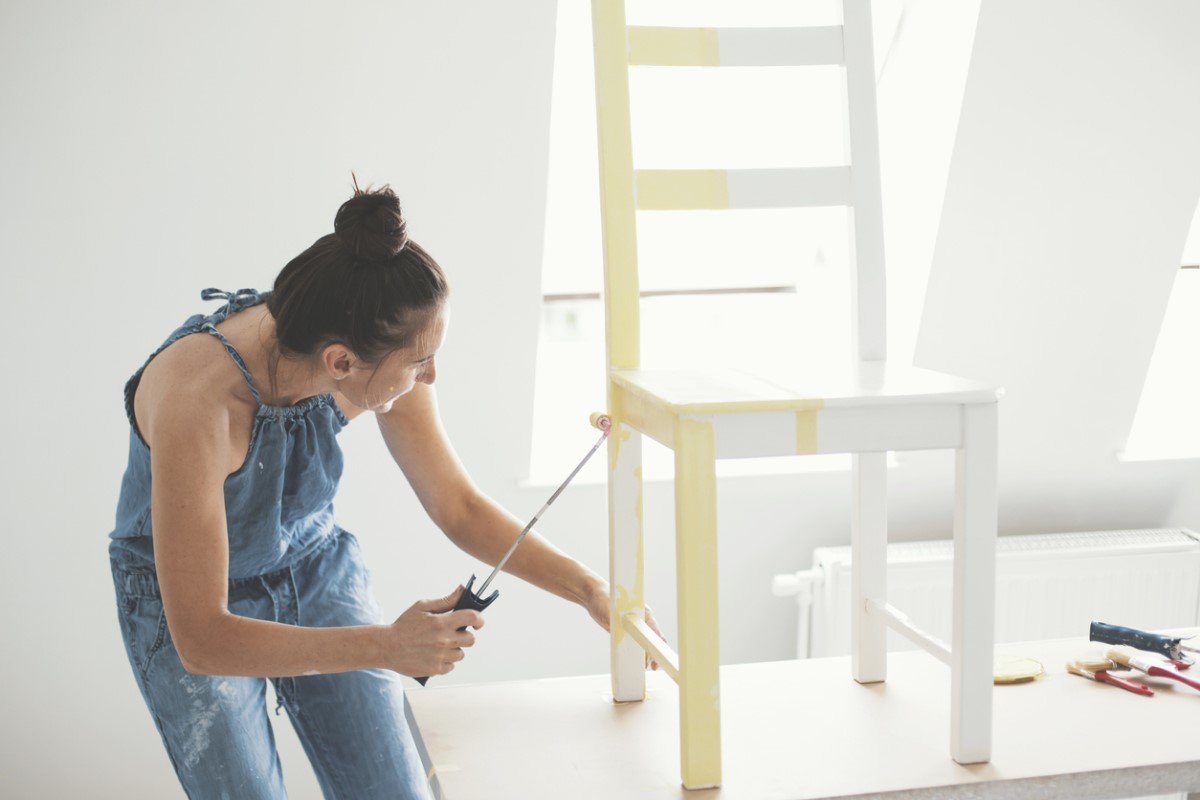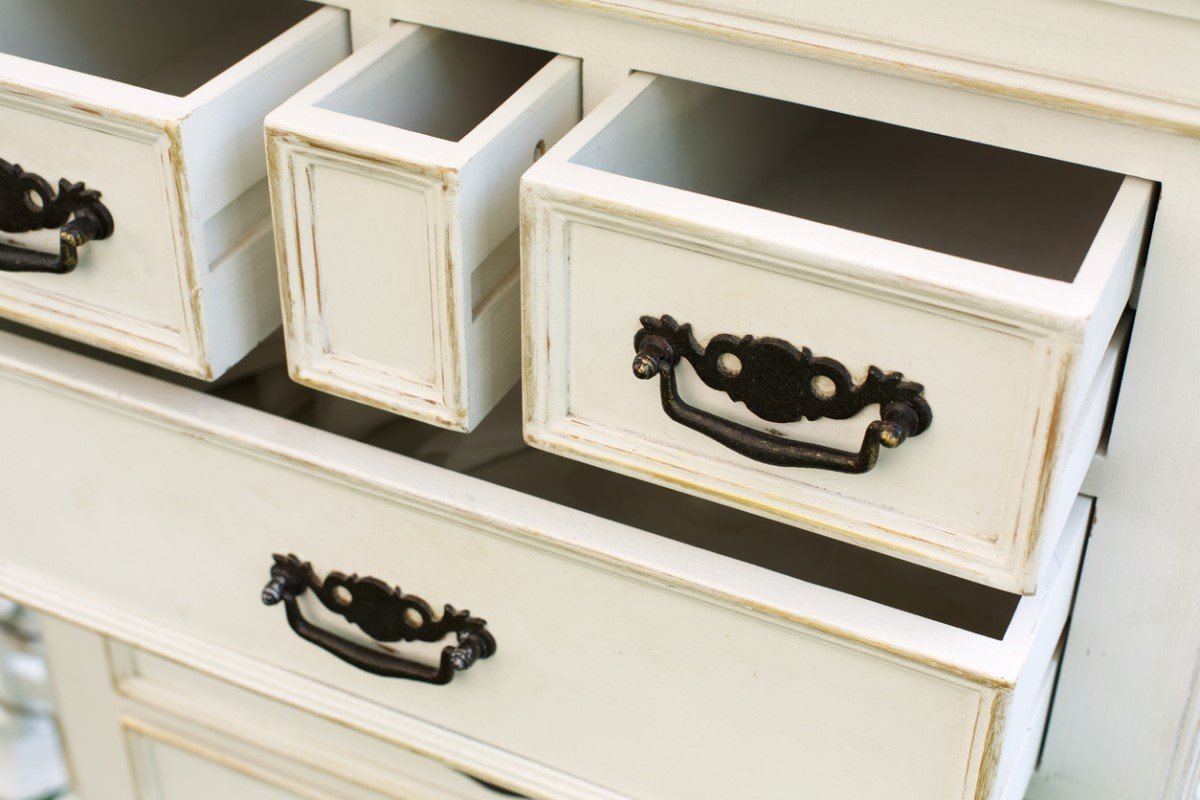
We may earn revenue from the products available on this page and participate in affiliate programs. Learn More ›
Q: I want to renew a recently purchased thrift store chair with paint. What’s the best paint to use on furniture?
A: Although some paint brands carry dedicated furniture paint designed to dissuade brush marks and protect against scuffs (like Valspar’s Furniture Paint, available at Lowe’s), it can be pretty pricey—as much as $26 for a 29-ounce can. That may be more than you paid for your thrift store furniture! Fortunately, you can save money for any furniture painting project by using a more standard paint that suits the material you’ll be refreshing and making sure to prep, prime, and protect the piece correctly. Read on to identify the best paint for furniture that’s located indoors and out as well as helpful how-to tips.
Satin or semi-gloss paints are ideal for most furniture pieces.
No matter whether you’re choosing an interior or exterior paint, you’ll see a range of sheens: flat (matte), eggshell, satin, semi-gloss, and high-gloss, in order of lowest to highest luster. These middle-of-the-road sheens both dry to a slick surface that’s easy to wipe clean than less-lustrous finishes while hiding scratches and scuff marks that a more reflective high-gloss sheen would emphasize.
RELATED: Satin vs. Semi-Gloss Paint: What’s the Difference?

Choose exterior latex paint for outdoor furniture.
Latex paint ($20 to $50 per gallon) labeled for exterior use is best for outdoor furniture from wooden or metal patio sets to plastic lounge chairs. It’s increasingly used instead of oil-based paint on furniture because it emits less volatile organic compounds (VOCs) and noxious fumes. It also dries faster than oil paint, in one to three hours, so you can quickly put the furniture to use. While all exterior latex paints contain a water base, pigment, binders (resins), and special additives that resist mildew, fading, and staining, the best paint for furniture is labeled “all-acrylic” or “100% acrylic,” which is more fade- and crack-resistant than latex paint containing vinyl or combined vinyl-acrylic resins.
Before painting furniture, sand the surface with a sanding block or sandpaper to even it out and roughen it up to improve paint adhesion, then clean with a rag soaked in soapy water to remove dust and grit. When dry, prime with a water-based primer labeled for exterior use (e.g., Zinsser Water-Based Interior/Exterior Primer, available at The Home Depot) to ensure an even foundation and a more uniform paint finish, ideally in a shade close to or tinted to the exact color of your paint. If painting metal, stave off rust by using an oil-based, rather than a water-based, exterior primer (e.g., KILZ Complete Oil-Based Primer, available at The Home Depot).
To avoid sun-related fading and fend off wear-and-tear from outdoor elements, seal painted furniture with a clear, exterior-grade, water-based polyurethane top coat (e.g., General Finishes High-Performance Water-Based Top Coat, available on Amazon).
Use interior latex paint if you want the furniture to match the walls.
Interior latex paint ($15 to $40 per gallon), containing a water base, pigment, binders, and additives, is also low in VOCs and fumes, adheres well to wood and metal furniture, and dries in one to three hours. It’s also a more affordable option when aiming to achieve color coordination between interior walls and furniture, because you can have white interior latex paint in the flaw-hiding, easy-to-clean satin or semi-gloss sheen tinted at the store to match virtually any wall color. Because you don’t need the weather resistance of a pricier all-acrylic latex paint on indoor furniture; a cheaper latex paint labeled vinyl or vinyl-acrylic will suffice.
You’ll still need to sand before painting and apply a coat of interior or interior/exterior water-based primer (the exception being metal furniture, on which you should use an oil-based primer). A top coat of clear polyurethane, while not required on seldom-used furniture in low-traffic spaces, will deter minor dents on workhorse pieces like coffee tables in family rooms and other high-traffic areas of the home.

Opt for milk paint to achieve a distressed look.
Milk paint ($15 to $25 per quart)—a water-based product made from natural ingredients including limestone, clay, pigment, and the milk protein casein—can give your furniture instant patina. Designed to self-distress (i.e., crack and flake) during the drying process and beyond, it’s perfect for obtaining a yesteryear look on a new vanity or playing up the aged beauty of an old armoire. While the paint comes in an array of traditional colors, is usually free of VOCs, and gives off only a mild earthy scent, it has a slightly longer dry time than latex paint, at two to four hours. It’s also sold in powder form that must be manually mixed with water and stirred before use.
Although you’ll need to wipe down the furniture with soapy water before painting, you can generally skip sanding and priming because milk paint adheres well to wood and metal surfaces both matte and glossy. Seal milk-painted furniture with a water-based wax top coat (e.g., Polyvine Wax Finish, available on Amazon) to make the naturally matte coat slicker and easier to wipe clean, stave off scratches, and preserve the distressed finish.
RELATED: Is Milk or Chalk Paint the Right Finish for You?
Choose chalk paint for a uniform finish without sanding, priming, or paint mixing.
For a low-effort project, chalk paint ($15 to $35 per quart)—a water-based product made from calcium carbonate, talc, and pigment—is ready-to-use on wood and metal furniture straight out of the can with no mixing and minimal surface preparation. Because it naturally adheres well to matte and glossy surfaces, there’s usually no need for sanding or priming beforehand.
Simply wipe down the furniture with a rag saturated in soapy water, pat it dry, and then load and take up your paintbrush. Chalk paint emits minimal VOCs and fumes and is most commonly sold in white to pale, whimsical hues such as powder blue. It lends a uniform, like-new finish to old furniture, from vanities to folding chairs. After chalk paint dries (in 15 minutes to an hour), seal it with a water-based wax top coat to add a soft shine to the naturally matte surface and achieve a slicker, easier-to-clean and harder-to-scratch surface.
